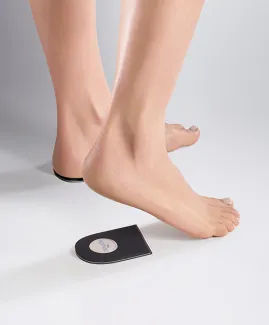
A heel spur and the inflammation usually associated with it called plantar fasciitis can cause severe heel pain. When your heel hits the ground, you get the painful feeling that your flesh is ripping up. With every step, you feel like a nail is driving into your foot.
But where does this severe pain come from? How to prevent heel spurs and how to relieve the pain from plantar fasciitis? EPITACT® answers your questions!
Before getting pain relief for plantar fasciitis: focus on its causes
Heel spurs are a consequence of the inflammation of the plantar fascia called plantar fasciitis. Such an inflammation occurs when the fascia has been overused or overextended. It leads to the formation of additional bone cells under the heel, where the plantar fascia attaches to the heel bone. By cumulating, they progressively create a pointy bone outgrowth called a heel spur. To prevent and relieve the pain from plantar fasciitis and heel spurs, it is necessary to reduce the stress on the plantar fascia to decrease inflammation.
How to relieve the pain from plantar fasciitis and heel spurs?
The ways of relieving plantar fasciitis pain all consist in reducing the pressure on the bottom of the heel or to stretch the plantar fascia.
Shoe inserts
If a surgical intervention is the radical solution to get pain relief for plantar fasciitis, there is fortunately a less invasive alternative: the EPITACT® silicone heel lifts*.
By raising the heel of a few millimetres, they reduce the stress on the plantar fascia. Made of open cell foam, these silicone protections absorb the shock waves generated when the heel hits the ground.
The vibrations are reduced and shocks are absorbed for a greater comfort. The centre of each heel lift* is made of the EPITHELIUM 26® silicone gel, which limits the pressure on the painful area.
Ice packs to ease the pain from plantar fasciitis
If your foot has been overused, you can also soothe the pain by applying ice on your feet for ten minutes. Keep your feet up to help the blood circulation.
Plantar fasciitis pain relief with massages and stretches
Regular massages and stretches of the plantar fascia can also relieve the pain of plantar fasciitis, relax the foot and limit the development of the bone excrescence.
In order to do that, roll a tennis ball or a plastic bottle filled with sand under your foot arch.
Sessions with a physical therapist can also ease the pain from heel spurs thanks to shock wave application and exercises to stretch the bottom of your foot and the calf muscles.
Medications
If pain and inflammation don’t reduce, taking non-steroidal anti-inflammatory drugs (aspirin, ibuprofen) can provide plantar fasciitis pain relief momentarily.
Injections remain the most durable alternative provided that they are properly done and under local anesthaesia.
Surgery
In severe cases accompanied with extreme foot pains, surgery will reduce tensions by partially severing the plantar fascia. However, be careful of possible complications such as fallen arches.
How to prevent plantar fasciitis and heel spurs?
We can all agree; the best option is to prevent heel spurs and plantar fasciitis before they occur avoid a Lenoir’s thorn and inflammation. To do so, several things can help you limit the risks of developing such painful conditions.
The importance of wearing supportive shoes
Start by choosing better shoes with good arch support. If you’ve ever had really sore feet, you’ll gladly sacrifice your look for shoes that suit your foot shape. Forget high heels that contribute to the inflammation of the plantar fascia and choose shoes with a comfortable and cushioning sole.
Losing weight and wearing insoles
Being overweight, as well as having hollow feet, flat feet or postural disorders of the feet (valgus or varus deformities) are factors contributing to the development of this kind of inflammation. To prevent or relieve the pain from plantar fasciitis, follow a balanced and varied diet and see your doctor to see if you need orthopaedic insoles.
Heel lifts
If you regularly participate in sports or other physical activities that require intense use of the foot, don’t forget to prevent heel spur pain by regularly wearing the EPITACT® silicone heel lifts*.
Lastly, if you are worried about a recurrence, consult a specialist to consider rehabilitation sessions and get custom advice for plantar fasciitis pain relief. Physical therapy will teach you how to release the stress under your foot and prevent plantar fasciitis and heel spurs.

*This solution is a class I medical device that bears the CE marking under this regulation. Carefully read the instructions before use. Manufacturer: Millet Innovation. 04/2020.
 Pharmacie
Pharmacie